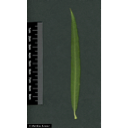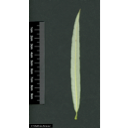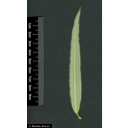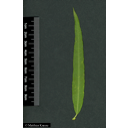Useful information about the taxon (species, subspecies, variety...)
Salix viminalis L. 1753
Salicaceae
(APG IV)basket willow, common osier, osier
Taxon concept: The Plant List (2014), version 1.1
Distribution: Europe: France and Benelux, Central Europe, eastern Middle Europe, Balkan Peninsula, East Europe, Caucasian States, Iran, Himalaya, West and East Siberia, Mongolia, China, Japan; naturalised on the British Isles, Iberian Peninsula, Apennine Peninsula and in Scandinavia
Size: 3 - 8 (m)
Flowering period: III - IV
Salix viminalis L. - : Salix viminalis L. bei Zander 2008; Familie: Salicaceae (Zander 2008)Salix viminalis L. - Accepted: Salix viminalis L. bei The Plant List (2010); Familie: Salicaceae (APG III)Salix viminalis L. - Accepted: Salix viminalis L. bei The Plant List (2014), version 1.1; Familie: Salicaceae (APG III)Salix viminalis L. - Accepted: Salix viminalis L. bei Schmeil-Fitschen 2019; Familie: Salicaceae (APG IV)Salix viminalis L. - Accepted: Salix viminalis L. bei BfN Checklist Flora DE; Familie: Salicaceae (APG IV)Salix viminalis L. - Accepted: Salix viminalis L. bei World Flora Online - APG IV (Angiosperms); Familie: Salicaceae (World Flora Online - APG IV (Angiosperms))
- Flowers
- dioecious
- Flower ecology
- insect-pollinated (entomophilous) (bees)
- Life form
- woody, shrub
- Foliage persistence
- deciduous
- Soil conditions
- preferentially on perculating wet, periodically flooded, nutrient-rich and alkaline, mostly calcareous, mainly clayey, also sandy-gravelly alluvial soils
- Succession type
- pioneer plant
- Natural occurrence (habitat)
- banks of rivers and ditches
- Vegetation typ and synecology (plant community)
- temperate, broad-leaved deciduous forests; often in association with Salix triandra, character species of the Salicetum triandrae (Salicion albae)
- Constraints according soil conditions
- not salt tolerant
- Constraints according habitat
- tolerant to atmospheric pollution
- General recommendation
- recommended for beekeeping
- Usage
- wood is used for basket making; useful for consolidation of riverbanks
Bundesamt für Naturschutz (BfN) (1999-2001 and ongoing): Floraweb - Daten und Informationen zu Wildpflanzen und zur Vegetation Deutschlands. www.floraweb.de.; Erhardt, W., Götz, E., Bödeker, N. & Seybold, S. (2008): Der große Zander. Enzyklopädie der Pflanzennamen. Band 2. Arten und Sorten. Eugen Ulmer KG, Stuttgart (Hohenheim), 18. Aufl., 2103 S.; Haider, M. et al. (2005): Wildbienenkataster. See: https://www.wildbienen-kataster.de; Ministerium für Ernährung, Landwirtschaft, Umwelt und Forsten, Baden-Württemberg (Hrsg.) (1985): Pflanzenkatalog zur Verbesserung der Bienenweide und des Artenreichtums (Kurztitel: Bienenweidekatalog); Oberdorfer, E. (2001): Pflanzensoziologische Exkursionsflora. Für Deutschland und angrenzende Gebiete. Eugen Ulmer Verlag, Stuttgart, 8., stark überarb. u. erg. Aufl, 1056 S. 978-3-8001-3131-0.; Pritsch, Günter et al. (1985): Bienenweide.. Neumann-Neudamm, Melsungen; Pritsch, Günter et al. (2007): 200 Trachtpflanzen erkennen und bewerten.. Kosmos, Stuttgart; The International Plant Names Index (2009). Published on the Internet http://www.ipni.org; Courtesy to IPNI, 2009. Exported from IPNI at date: 2009-09-22 20:17:51; Toker, G. et al. (2004): Flavonoids with antinociceptive and anti-inflammatory activities from the leaves of Tilia argentea (silver linden). J. Ethnopharmacol., 95(2-3): 393-397.; Westrich, P. et al. (2018): Die Wildbienen Deutschlands.. Ulmer Verlag ISBN 978-8186-0123-2.;
Diese Webseite verwendet Google Maps, um Karten und Standorte von Pflanzen in den Hohenheimer Gärten anzuzeigen. Dadurch werden unter Umständen Daten an Google weitergeleitet, was mit einer Verarbeitung Ihrer personenbezogenen Daten verbunden sein kann. Die Datenschutzerklärung von Google finden Sie hier: Datenschutzerklärung von Google
| Sex | Standort | Accession number | Planting year | Donation | IPEN | Lat. | Long. |
|---|---|---|---|---|---|---|---|
| Baumschule Hohenheim | BS-22537 | XX-0-HOH-BS-22537 | 0 | 0 | |||
| Parzelle X | LG-X-311-25464 | 2022 | XX-0-HOH-LG-X-311-25464 | 48,705053 | 9,213785 | ||
| Vegetationsgeschichte | VG-5472 | 2023-04-22 | XX-0-HOH-VG-5472 | 48,710718 | 9,215284 |




